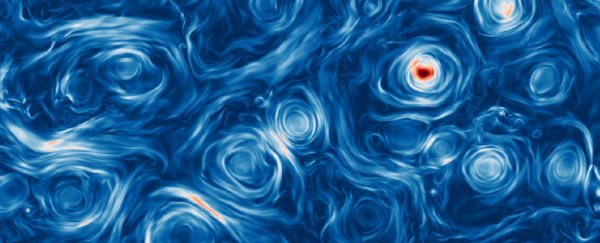There's some irony in the fact that the darkest objects in the sky - black holes - can be responsible for some of the Universe's brightest light. Simulations of the magnetic fields surrounding black holes and neutron stars have now provided new insights into their astonishing brilliance.
Astrophysicists from Columbia University in New York have developed a model that shows how electrons taking a cosmic roller coaster-ride through magnetic turbulence can generate surprisingly energetic waves of radiation.
Applied to the swirling chaos surrounding dense objects such as black holes, it helps to explain why we see them glow with a ferocity that so far defies explanation.
There's no argument that at least some of that luminosity is from particles being whipped into a heated frenzy in the disk of gas and dust spiralling in to their doom.
Charged particles in that swirling debris can also generate some seriously mad magnetic fields, channelling material into jets that eject particles light years into space, at speeds that cause them to glow with hard electromagnetic radiation.
But amid the spectrum of photons emitted from the space around some black holes and neutron stars are waves that can't easily be explained. They're too energetic to be thermal, and don't seem to come from zones where gas and dust is being channelled.
That's not to say there aren't other ways matter can't be accelerated to the kinds of speeds that would emit the right level of electromagnetic radiation.
"Turbulence and magnetic reconnection – a process in which magnetic field lines tear and rapidly reconnect – conspire together to accelerate particles, boosting them to velocities that approach the speed of light," says one of the study's two researchers, Luca Comisso.
If you think about the neat rows of lines that appear when you sprinkle iron filings around a permanent magnet, magnetic fields are like laneways for charged particles.
Move those magnets around in a wild, unpredictable fashion, and those electron roads will disconnect and reconnect with one another, turning a leisurely drive into a theme park ride from hell.
The chaos of turbulent magnetic fields around our own planet has helped to explain a bunch of astrophysical phenomena in the past, such as where the energy of high speed electrons goes when they collide with our magnetosphere.
"It is thanks to the electric field induced by reconnection and turbulence that particles are accelerated to the most extreme energies, much higher than in the most powerful accelerators on Earth, like the Large Hadron Collider at CERN," says Comisso.
Given the success turbulence has had elsewhere, it's a tempting idea to explore when it comes to the high energy physics produced by black holes. The only problem is the unpredictable writhing of turbulent magnetic fields isn't exactly the easiest thing to model mathematically.
To simplify the task, the researchers broke down the busy movements of particles in a plasma into units that can be more easily calculated.
"We used the most precise technique – the particle-in-cell method – for calculating the trajectories of hundreds of billions of charged particles that self-consistently dictate the electromagnetic fields," says Comisso's colleague, Lorenzo Sironi.
"And it is this electromagnetic field that tells them how to move."
Their results showed how electrons whipping back and forth through restless magnetic spaghetti could potentially generate the energies required for radiation well beyond what heat could generate alone.
Most of that extra energy, they showed, comes from random movements at extremely high speeds. As the charged particles curve, they emit powerful waves of electromagnetic radiation.
"This is indeed the radiation emitted around black holes and neutron stars that make them shine, a phenomenon we can observe on Earth," says Sironi.
One of the stranger objects in our Universe is the dense remains of a supernova at the centre of the Crab Nebula. Physicists have been curious about its high speed electrons for some time.
The two researchers now plan to apply their results directly to the nebula's spectrum, in an effort to show how this enigma might be explained by turbulence alone.
"We figured out an important connection between turbulence and magnetic reconnection for accelerating particles, but there is still so much work to be done," says Comisso.
This research was published in The Astrophysical Journal.
